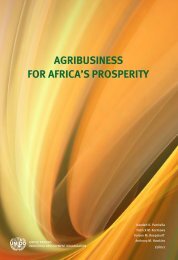Collection of Case Studies 2. - Seas of Change Initiative
Collection of Case Studies 2. - Seas of Change Initiative
Collection of Case Studies 2. - Seas of Change Initiative
You also want an ePaper? Increase the reach of your titles
YUMPU automatically turns print PDFs into web optimized ePapers that Google loves.
approving miller groups in line with government policy. The Ministry <strong>of</strong> Agriculture and Forestry is receivingsupport from the World Bank and FAO to develop a national rice strategy utilising the successful experiencesderived from EMRIP.3. Evolution <strong>of</strong> the initiativeEMRIP recognised that the private sector and the public sector both have important roles to play in developingthe country’s rice sector. The major constraints in the rice sector in Laos were the use <strong>of</strong> low quality andinadequate inputs by the farmers; poor farming practices and poor post-harvest handling by both farmers andmillers. The local rice mills are the ones with highest leverage in the rice value chain. Their position in the valuechain is such that they are best in unblocking these key constraints to increase productivity. The project hasworked with 21 progressive and socially committed millers who have strong and mutually respectful relationshipswith small-holder rice farmers. Each participating miller provides quality inputs, credit and training toapproximately 1,000 producers, allowing them to increase productivity, unblocking the key constraints to riceproduction in Lao PDR. In return for investing their time and money in small farmers, millers received projectsupport to improve milling facilities and equipment. Improved milling efficiency and higher quality rice furtherincreased the amount <strong>of</strong> rice available in Laos while improving pr<strong>of</strong>itability for farmers and millers and greaterstability <strong>of</strong> supply <strong>of</strong> good quality rice for consumers.The rice mills participating in the project have taken a lead role in forming miller groups in their respectivedistricts and provinces following the Khammouane Development Rice Miller Group as a role model. There hasbeen almost a proliferation <strong>of</strong> miller groups, with a total <strong>of</strong> 14 miller groups with 261 mill members nowoperating across five <strong>of</strong> six target provinces. Most convincing are the five miller groups in KhammouaneProvince. All 85 members <strong>of</strong> these miller groups have already started applying the EMRIP approach in creatingand working with farmer networks. The number <strong>of</strong> farmers these millers are linked with and their trade volume isnot included in this case study.Government also has played an important role in facilitating and supporting the development <strong>of</strong> the rice sector.The role <strong>of</strong> government is mainly creating an enabling environment for the market actors in the rice value chain.Responsibility for rice production and milling is split between different government departments, and there is n<strong>of</strong>orum to bring all stakeholders together to discuss policy issues facing the rice industry. The main governmentpartners at province level are the Department <strong>of</strong> Agriculture and Forestry and the Department <strong>of</strong> Industry andCommerce.A “bottom-up” approach to policy formulation has been implemented, starting with multi-stakeholder meetings inthe target provinces and which has then been followed by national level meetings.4. ImpactThe overall goal <strong>of</strong> the project was to rapidly increase the quantity and stability <strong>of</strong> supplies <strong>of</strong> good quality milledrice for domestic consumption and trade. The main outcome set by the project was to facilitate the production <strong>of</strong>20,000 metric tonnes <strong>of</strong> good quality milled rice through 20 rice mills via fair trading relations with 20,000farming households within 23 months <strong>of</strong> the project’s duration. We outline below whether these outcomes werereached, as well as some other outcomes and impacts <strong>of</strong> the project.The project was able during its entire 23 month duration to connect 21,361 smallholder rice producers with the21 rice mills. The producer network <strong>of</strong> each miller typically comprises 10 to 15 villages with about 1,000inhabitants.Improved Grain qualityMost <strong>of</strong> these farmers previously used a variety <strong>of</strong> seeds, which in some cases were over a decade old. Supply<strong>of</strong> high yielding varieties <strong>of</strong> fresh seed by the millers to farmers resulted in (a) production and supply <strong>of</strong> singlevariety paddy rice being returned to the mills; and (b) intact, s<strong>of</strong>t and aromatic grain. The final project evaluationcarried out by an independent external evaluator mentioned the following impact from increased grain quality:Mills shifted from a 100% mixed/general grade mix to an increased proportion <strong>of</strong> single variety grade grain,from at least 100% mixed variety to 20 to 70% single variety.Mills are obtaining 9 to 14% gains in prices for quality milled riceFarmers are receiving a 10% gain in terms <strong>of</strong> premium prices with those mills accessing quality markets20







